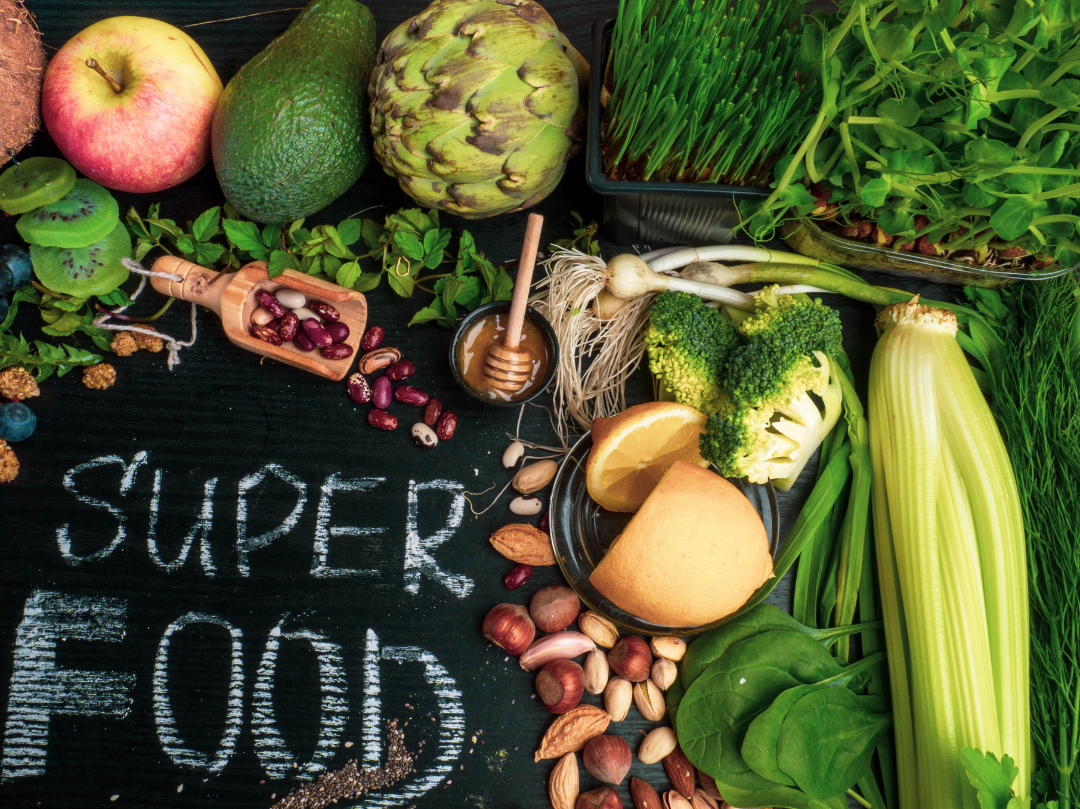Separating fact vs. fiction when it comes to choosing Superfoods to add to your diet
Where did the term Super Food come from and why does it seem like every other month there is a new one that we should be eating? Today, many foods have been labelled as super foods, broccoli, avocado, the list goes on. But what is the criteria for being considered a “super food”? According to Dr. Ken Berry, “a super food is a nutrient dense, ancestral food that supplies amino acids, fatty acids, vitamins and minerals which are bioavailable, low in sugar and is un-inflammatory to the body and mind”.
Unfortunately, the term super food has been utilized by food producers for marketing purposes to sell their food as healthy when, in reality, it may not be that “super”, but where did this start? To find the answer, we must look back to the early 1900’s when the united fruit company began to import lots of bananas into the USA. They marketed the fruit as a convenient snack, that was delicious and easy to eat. Unfortunately, their marketing efforts did not catch on very well, so they began to reach out to doctors and medical organizations, like the American medical association for help. They paid doctors to advocate for the medicinal qualities of bananas. They applauded bananas as a nutrient dense, healthy snack. A “super food”. The American medical association even went as far as to say that bananas would cure silica spurs, a symptom caused by a gluten allergy. Through this marketing campaign, the term super food was coined.
Today, we know that bananas are not, in fact, a super food. They are basically just a yellow fruit filled with lots of sugar, a bit of minerals and vitamins, but not much more than that. However, the marketing of bananas as a super food was so successful that other food companies learned that if you advertised a product as a “super food”, you could charge more for it and it still generate “super” sales.
Now, before we get into some real super foods that you should be incorporating into your diet, let’s touch on a few fake super foods that almost everyone thinks are super foods. The first fake super food is grains of any kind. Grains are void of nutrients, so much so that they must be fortified with fake vitamins and minerals. There is also a large percentage of the global population who have serious allergies to gluten and gelatin who can’t eat whole grains at all.
The next fake super food is dark chocolate, it’s always been seen as a miracle cure for this or that, because it has so-called “miracle” phyto chemicals and nutrients that you can’t get anywhere else. The problem with these claims is that these so called phyto chemicals and nutrients have never been proven to be necessary for optimum human health, there is no proof anywhere.
Lets talk about a more recent “super food”, kale. Kale has had such successful marketing efforts declaring it a super food that it can be found in almost an restaurant or grocery store. It’s supposed to be a super food because it has so much vitamin A in it. But does it have any vitamin A at all? The truth the may surprise you. Kale has zero real vitamin A. In fact it only has beta carotene, which some of us can convert to vitamin A however the majority of people do not have the machinery to convert it. Kale is often sold at a premium, but truth be told that if it were sold at its true market value, the grocery store would have to pay you to take it.
The next fake super food is Manuka honey, or any other “magical honey”. A small jar of Manuka honey can cost as much as $50 for 2ozs. Like the other super foods on this list, this is 100% a marketing ploy to increase profits. Any honey, from the cheapest that has been cut with corn syrup, all the way up to the most premium expensive honey, is only sugar and water. It spikes your blood sugar and your insulin, it is not a super food.
Next we have pomegranate or pomegranate juice. When you look at the nutritional value, there might be some phyto nutrients that might be good or not, but like dark chocolate, there is no proof that it is beneficial for your health. Take a bottle of orange juice and a bottle of pomegranate juice and compare the nutritional value, you will see there is nothing special about pomegranate juice.
Now that we’ve covered a variety of fake “super foods” lets talk about some real, and often less appreciated, super food, lets start with eggs. We’ve talked about eggs before on this blog but they are worth mentioning time and time again. With the yolk included, the nutritional value and quality, of an egg that came from a well posturized chicken, is off the charts. (Go back to my pervious blog on eggs, and you will see what I mean.)
The next real super food is sardines and anchovies with the skin on and bones in. These small fish are packed full of nutrition, according to a Harvard study, consuming 1-2 servings of sardines every week can reduce your chances of heart disease by more than one-third. Anchovies are also rich in omega-3 fatty acids, they reduce triglyceride levels and snow the buildup of plague in your arteries.
The next super food that is really a super food is liver, this includes cod liver oil, beef liver, chicken liver, the liver of an animal that as been pasteurized in the right way. Liver is incredibly nutrient dense, rich in protein and low in calories. It is also packed with essential vitamins and minerals like vitamin A and vitamin D. The nutritional value when compared to any other super food, is way off the charts.
The next super food are fish eggs or fish roe. Much like the eggs from a fowl, roe contains every thing a human needs to thrive. They are packed with omega-3 fatty acids, eicosapentaenoic acid, and docosahexaenoic acids. Eating fish roe is better for you than fish oil supplements as there are a natural source of all the above mentioned acids and vitamins and there is less risk of oxidizing during processing.
With all the “super foods” marketed in grocery stores today, it is hard to know what super foods are truly beneficial and what is not. Unfortunately, as we have discussed in prior blogs, food producers do not always have your best interest in mind, their interest is profit and their bottom line. It is important to research any foods that you eat or are interesting in adding to your diet as the marketing of a food as a “super food” may not be the reality of the product. Here is your take-away, you will never see “super food” marked on a real super food, but you will see it marked on a fake super food. It all comes down to deceptive marketing practices that producers know will generate profit.

